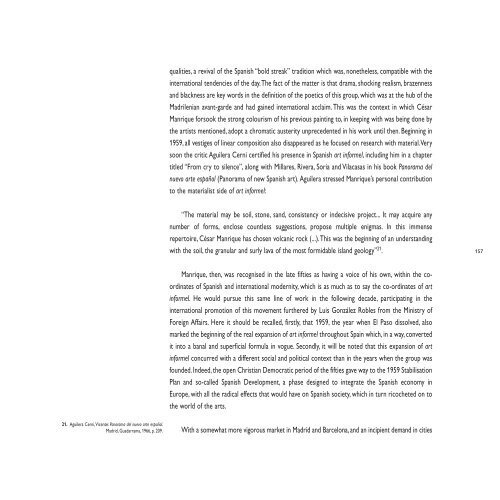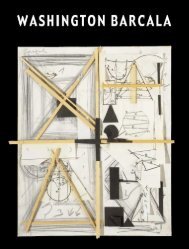VERSIÓN INGLESA ENGLISH VERSION - Fundación César Manrique
VERSIÓN INGLESA ENGLISH VERSION - Fundación César Manrique
VERSIÓN INGLESA ENGLISH VERSION - Fundación César Manrique
Create successful ePaper yourself
Turn your PDF publications into a flip-book with our unique Google optimized e-Paper software.
21. Aguilera Cerni, Vicente: Panorama del nuevo arte español.<br />
Madrid, Guadarrama, 1966, p. 209.<br />
qualities, a revival of the Spanish “bold streak” tradition which was, nonetheless, compatible with the<br />
international tendencies of the day. The fact of the matter is that drama, shocking realism, brazenness<br />
and blackness are key words in the definition of the poetics of this group, which was at the hub of the<br />
Madrilenian avant-garde and had gained international acclaim. This was the context in which <strong>César</strong><br />
<strong>Manrique</strong> forsook the strong colourism of his previous painting to, in keeping with was being done by<br />
the artists mentioned, adopt a chromatic austerity unprecedented in his work until then. Beginning in<br />
1959, all vestiges of linear composition also disappeared as he focused on research with material. Very<br />
soon the critic Aguilera Cerni certified his presence in Spanish art informel, including him in a chapter<br />
titled “From cry to silence”, along with Millares, Rivera, Soria and Vilacasas in his book Panorama del<br />
nuevo arte español (Panorama of new Spanish art). Aguilera stressed <strong>Manrique</strong>’s personal contribution<br />
to the materialist side of art informel:<br />
“The material may be soil, stone, sand, consistency or indecisive project... It may acquire any<br />
number of forms, enclose countless suggestions, propose multiple enigmas. In this immense<br />
repertoire, <strong>César</strong> <strong>Manrique</strong> has chosen volcanic rock (...). This was the beginning of an understanding<br />
with the soil, the granular and surly lava of the most formidable island geology” 21 .<br />
<strong>Manrique</strong>, then, was recognised in the late fifties as having a voice of his own, within the coordinates<br />
of Spanish and international modernity, which is as much as to say the co-ordinates of art<br />
informel. He would pursue this same line of work in the following decade, participating in the<br />
international promotion of this movement furthered by Luis González Robles from the Ministry of<br />
Foreign Affairs. Here it should be recalled, firstly, that 1959, the year when El Paso dissolved, also<br />
marked the beginning of the real expansion of art informel throughout Spain which, in a way, converted<br />
it into a banal and superficial formula in vogue. Secondly, it will be noted that this expansion of art<br />
informel concurred with a different social and political context than in the years when the group was<br />
founded. Indeed, the open Christian Democratic period of the fifties gave way to the 1959 Stabilisation<br />
Plan and so-called Spanish Development, a phase designed to integrate the Spanish economy in<br />
Europe, with all the radical effects that would have on Spanish society, which in turn ricocheted on to<br />
the world of the arts.<br />
With a somewhat more vigorous market in Madrid and Barcelona, and an incipient demand in cities<br />
157
















![Becas y premios de la Fundación César Manrique [1997-2006]](https://img.yumpu.com/20766851/1/184x260/becas-y-premios-de-la-fundacion-cesar-manrique-1997-2006.jpg?quality=85)
